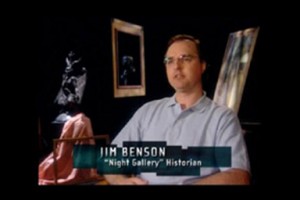Over the past two decades, Jim Benson has appeared on dozens of radio and television programs, including most recently Penn & Teller’s Bullshit!, and productions for TV Land, Showtime, Nick at Nite, NBC/Universal, CBS Entertainment, and Starz/Encore.
Jim Benson’s TV Time Machine has been featured in multiple newspapers and websites, and his writing and insights on classic TV and its influences have appeared in myriad publications, including The Washington Post, Emmy Magazine, TV Guide, The Twilight Zone Magazine, and Television Chronicles.
New Jersey Courier-Post
By Frank Halperin
| “Jim Benson’s TV Time Machine” Our popular culture has always been a giant dryer, where countless popcult items have become lost — just like the “missing socks” in Jerry Seinfeld’s classic bit of stand-up.Actually, there’ve been plenty of “machines” — especially TV shows from the 1970s — that have disappeared into the nether regions of the pop culture machine: things like “The Harlem Globetrotters Popcorn Machine” and “Marlo and the Magic Movie Machine” (once must-see children’s TV); “The Great American Dream Machine” (pre-“Saturday Night Live” satirical hodgepodge on PBS, lodged with comedic upstarts Chevy Chase and Albert Brooks); and “The Magnificent Marble Machine,” a tilted game show from 1975-76 in which contestants tried to win prizes by playing a colossal pinball machine.
Jim Benson, host of the “TV Time Machine” online radio show, has spent plenty of time poking his head through the pop culture dryer, shaking the lint off of classic television and neatly folding them into entertaining, informative discussions about them. On the site, Benson sends visitors tumbling through TV’s past and enlightens them to some valuable video lessons during their spin. Submitted for your (listening) approval: an interview with “Scientific American” editor-in-chief John Rennie about how such legendary sci-fi TV shows as “The Twilight Zone,” “The Outer Limits” (the show’s preternatural “Do not adjust your TV set . . .” intro leads off the one-hour broadcast) and “Star Trek” foreshadowed the realization of today’s cell phones, microwave ovens and other technological marvels. Would you believe you can also hear comedy deity Mel Brooks recall his work in television, including the co-creation of “Get Smart” with Buck Henry and the “2000 Year-Old Man” character with Carl Reiner? There’s plenty of talk soup for you as well, once you listen to actor Larry Thomas talk about his “Soup Nazi” character from “Seinfeld.” Along with his archived shows, Benson upgrades his “TV Time Machine” with new broadcasts every few weeks. Who knows what sonic screen gems he has socked away for the coming months . . . stay tuned and find out. Readers are invited to submit their pop culture tips. Reach Frank Halperin at (856) 486-2920 or fhalperin@courierpostonline.com. |
Hits And Mrs.
Overly Dysfunctional or a Bit Too Perfect, TV Couples Create Their Own Realities
By Marc D. Allan
Special to The Washington Post
Marriage had a particularly rough year during the 2006-07 TV season. If it wasn’t Tom and Lynette bickering about their restaurant business and the hot new chef on “Desperate Housewives,” it was the rash of new shows that made matrimony look miserable.
Wedding planning (“Big Day,” “The Wedding Bells”), ceremonies (“The Real Wedding Crashers”), real-life couples (“Marriage 911,” the new “Ex-Wives Club”) and fictional ones (“‘Til Death,” “Rules of Engagement”) all made “I do” seem like the last words anyone would ever want to say.
It’s hard to find a healthy marriage on TV today. But then, television has a long history of looking at marriage through a bizarre prism in which the couples are either carping at each other or are confined to the stereotypical roles of wife as mother figure and husband as an oversize kid.
“I hate it,” said actress Megyn Price, who plays Audrey on the CBS sitcom “Rules of Engagement.” “I feel like there are so many television couples that you just don’t buy.
“You don’t see any of the love, you don’t see anything sexy, you don’t see any part of the marriage that seems like fun,” Price said. “It all seems like hell on wheels.”
Finding a balance has long been a challenge for TV couples, from Fred and Ethel Mertz on “I Love Lucy” and Ralph and Alice Kramden on “The Honeymooners” — who barked at each other constantly — to the characters on “Everybody Loves Raymond” and the couples on “Desperate Housewives.”
Hidden secrets and lusts may make for good drama, but not for a happy marriage.
Sheri Stritof, who writes about marriage with her husband, Bob, at marriage. about.com, said television rarely gets it right, regardless of the era.
Couples “have the big fight, then everything’s okay in a half-hour or an hour, depending on the show,” Stritof said. “But that’s not real life. So people are not given realistic expectations about communication tools in marriage.”
Jim Benson, host of the Internet radio show “TV Time Machine,” said early TV shows generally showed marriages with strong father figures such as Ward Cleaver on “Leave It to Beaver” and Jim Anderson of “Father Knows Best,” where the problems the family faced were relatively simple. Then “All in the Family” came along and television families became more realistic — and angrier.
“I know it’s sort of a cliche, but it’s true. I think the 1960s had a lot to do with it,” Benson said. “The social changes that occurred then — there was a lot of rebellion and negative reaction toward the perceived oppressiveness of the way society was structured in the 1950s.”
But while television usually reflects society, it also mirrors the sensibilities of the people who create the shows. So sometimes, happiness wins out.
“The Cosby Show” was the brainchild of Bill Cosby, who would hold lavish “I Love My Wife” parties for his real-life spouse, Camille. Cosby’s TV wife, Phylicia Rashad, said he was replicating his own marital experience.
“Love comes in all shapes and sizes, degrees and manifestations,” she said. “What we did was a lot of fun. It was a lot more fun than arguing.”
On the other hand, Phil Rosenthal, who created “Everybody Loves Raymond,” grew up in a house whose mood resembled that of “The Honeymooners.” So “I was just writing about the family that I knew,” he said.
“We were trying to keep it real,” Rosenthal said. “We’d come in in the morning and say, ‘What happened in your house this week?’ And all the stories came from that.
“I think people took comfort in ‘Raymond’ in that it was ‘The Brady Bunch’ of its time because they were together,” he said. “That was the fantasy — with all the problems they had, they stuck together. You knew divorce was never a question in the ‘Raymond’ household.”
Carmen Finestra, who wrote for “The Cosby Show” and co-created “Home Improvement,” said he always wanted audiences to say: “How did you get into our house?”
“We used to have a slogan on ‘Home Improvement’ that the show’s premise was that men and women should not get married,” Finestra said.
“They’re so different in how they view life that it’s impossible for them to communicate with each other. But because they love each other, they find a way to overcome that and try to reach a middle ground.”
View all comments that have been posted about this article.
© 2007 The Washington Post Company
http://www.washingtonpost.com/wp-dyn/content/article/2007/06/05/AR2007060501462_pf.html






